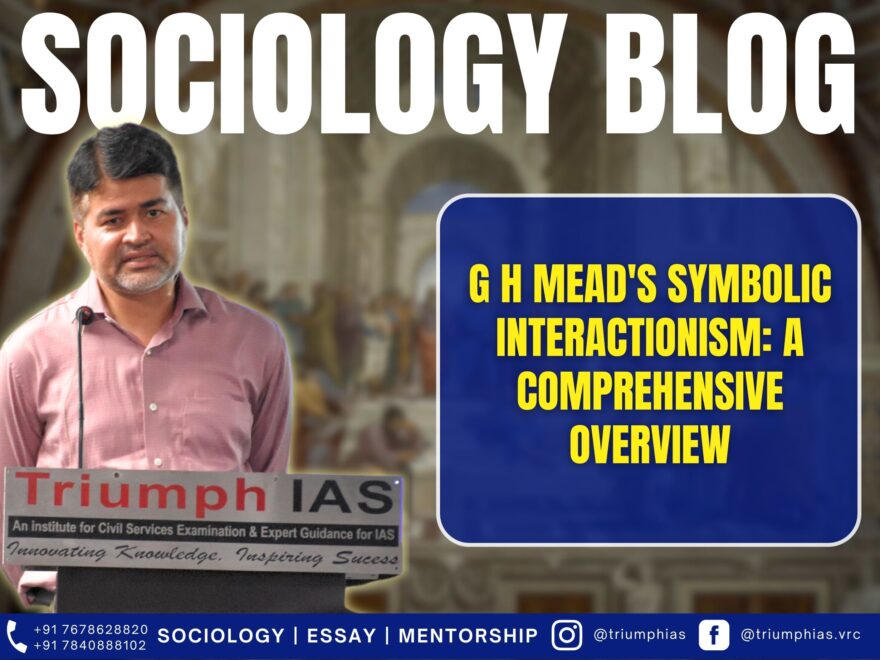
“Imagery is not past but present.
It rests with what we call our mental processes to place these images in a temporal order”
G H Mead: symbolic interactionism
Relevant for Sociology Paper-1 (Unit-4)
The term “symbolic interactionism” was introduced by Herbert Blumer, a student of Mead, in 1969. Blumer played a significant role in shaping this perspective and outlined its three fundamental principles:
- Human beings act based on the meanings they attribute to things.
- The meanings of things arise from social interactions.
- These meanings are shaped and adjusted through an interpretive process involving individuals interacting with one another.
The central focus of symbolic interactionism is on the concept of meaning, which is defined in relation to action and its consequences, reflecting the influence of pragmatism. The meaning of something is found in the action it elicits. For instance, “grass” holds the meaning of food for a cow, shelter for a fox, and so on. In the case of symbols, meanings also rely on a level of shared understanding between two or more people. The meaning of a word like “husband” depends on the collective understanding of those who use it. When there is a high level of agreement among users, the meaning of a symbol is clear. However, when consensus is low, the meaning becomes ambiguous, and communication becomes problematic. While cultures generally have a common consensus on the meanings associated with words and symbols, in practice, meanings are highly variable and subject to interpretation and negotiation among interactants.
The interpretive process involves what Blumer refers to as “role-taking,” which is the cognitive ability to understand and consider the perspective of others. Role-taking is crucial in communication as it allows individuals to interpret each other’s responses and leads to a greater consensus on the meanings of the symbols used. Determining meanings also relies on negotiation, which involves mutual adjustments and accommodations among the interacting individuals. In summary, meaning emerges through this dynamic process, it can be problematic, and its formation depends on role-taking and negotiation. Most concepts within symbolic interactionism are connected to the notion of meaning.
The origins of symbolic interactionism: Mead’s conception of behaviour
The classification of symbolic interactionism is broad and not universally embraced by many sociologists associated with it. The term itself captures the central idea of Mead’s social psychology, which asserts that human interaction is based on communication using symbols. Mead sought to explore the origins and development of humans’ ability to communicate through symbols, as well as its progression within each individual’s maturation process.
Mead’s View of The Self
According to Mead, the human mind, referred to as the “self,” emerges and evolves through the process of symbolic interaction, enabling individuals to develop a sense of their own individuality. Mead approached the development of the human mind from a Darwinian perspective, considering it as a result of the evolutionary process inherent in human biology and social nature. He believed that social life could be scientifically studied, as his social psychology drew upon biological principles. However, Mead criticized certain scientific attempts to understand human social life due to their limited understanding of scientific methods and the subject matter of human life.
Mead argued that the mind could be studied scientifically because its functioning is observable through people’s behavior, rather than being hidden behind it. The unique capacity of humans to respond to their environment in a more complex and adaptable manner compared to other animals is a consequence of human biology and its specific evolutionary development. For instance, a significant aspect of humans’ linguistic and symbolic abilities can be attributed to the evolution of their vocal cords.
Mead highlighted the distinction between animal responses, which are closely tied to immediate situations, and human responses, which can transcend such limitations. Humans possess the ability to reflect on past events long after they have occurred and anticipate and prepare for future situations. Our reactions in a given situation can depend on our preparation and planning, rather than being solely driven by automatic and instinctual responses, such as a reflex action like the knee-jerk reaction. While humans do exhibit reflex reactions, our behavior is not solely determined by them. Thus, Mead argued that individuals have control over their own behavior and are not simply reactive to external stimuli. This capacity to transcend immediate circumstances necessitates the development of symbolic abilities.
Symbolic Capacity
Our capacity for representation enables us to mentally recall or imagine past and future situations that are not currently present or have not yet occurred. This includes our ability to represent ourselves to ourselves. In order to prepare our behavior for future situations, we must be able to envision not only the situations themselves but also our actions within them. This means we can think about ourselves in the same way we think about objects and other individuals in the world around us. According to Mead, we can detach ourselves from immediate involvement in a situation and reflect upon it. We can also imagine how others in our situation would perceive us and see ourselves as others see us. This ability is known as self-consciousness.
The individual is not just a physical body but also an identity, a person with a distinct psychological character referred to as “the self” by Mead. This self is shaped and developed through interaction with other people and their behavior. For example, children initially learn through imitation, playfully copying the actions of others, pretending to be the postman, the shopkeeper, or their mother. Through this process, they learn about social roles and what is expected of individuals in society. By imitating these roles, children gain an understanding of how others perceive the world and how they relate to their role responsibilities. They learn to consider situations not only from their own perspective but also from the viewpoints of others. This understanding forms the basis for coordinating activities with others, allowing individuals to adjust their actions based on what they can anticipate from others’ perspectives.
While children do not develop a detailed understanding of how every person in society perceives things, they form a general sense of how others typically view the world. Mead referred to this general orientation as the “generalized other.” It is an important aspect of an individual’s psychology and represents the prevailing outlook of the community in which the child grows up. The shared attitudes within the community contribute to each individual’s personality.
To master these intricacies and fare well in the Sociology Optional Syllabus, aspiring sociologists might benefit from guidance by the Best Sociology Optional Teacher and participation in the Best Sociology Optional Coaching. These avenues provide comprehensive assistance, ensuring a solid understanding of sociology’s diverse methodologies and techniques
Symbolic Interactionism, G H Mead, Herbert Blumer, Interpretive Process, Role-taking, Negotiation, Conception of Behavior, Human Mind, Human Biology, Social Life, Self-Consciousness, Generalized Other.
Follow us :
🔎 https://www.instagram.com/triumphias
🔎https://www.youtube.com/c/TriumphIAS
https://t.me/VikashRanjanSociology
Find More Blogs
|
Scope of the subject and comparison with other social sciences |
|||
|
|
|
|
Modernity and social changes in Europe |

